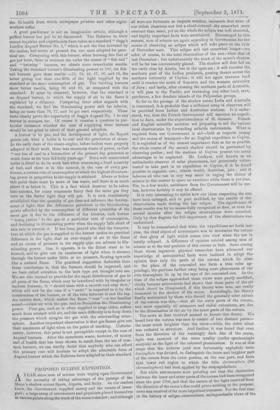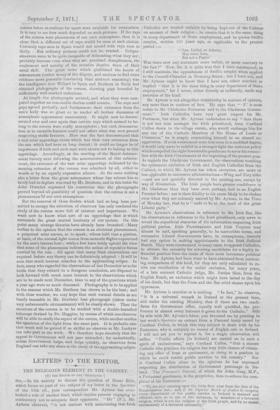PROPOSED ECLIPSE EXPEDITION.
A YEAR since men of science were urging upon Government
the necessity of taking advantage of the passage of the Moon's shadow across Spain, Algeria, and Sicily. As our readers know, the Government supplied money and the means of trans- port ; .a large array of astronomers and physicists placed themselves at various points along the track of the moon's shadow; and although
all were not fortunate as respects weather, insomuch that some of our ablest observers saw but a cloud-covered sky somewhat more overcast than usual, yet on the whole the eclipse was well observed, and highly important facts were ascertained. Encouraged by this. success, men of science are again appealing to Government for the means of observing an eclipse which will take place on the 12th. of December next. This eclipse will last somewhat longer—we refer, of course, to the total obscuration of the sun—than that a last December ; but unfortunately the track of the moon's shadow will be far less conveniently placed. The shadow will first fall on the earth close by Arabia, but in the open sea ; it will traverse the southern part of the Indian peninsula, passing thence across the northern extremity of Ceylon ; it will not again traverse land until it reaches the south of Sumatra and the western extremity of Java ; and lastly, after crossing the northern parts of Australia, it will pass to the Pacific, not traversing any other land, save, perchance, a few desolate islands of the Polynesian groups.
So far as the passage of the shadow across India and Australia. is concerned, it is probable that a sufficient array of observers will be provided from Indian and Australian stations. It is under- stood, too, that the French Government will sanction an expedi-. tion to Java, under the superintendence of M. Janssen. French and English scientific societies pie preparing to aid the various. local observatories by forwarding suitable instruments. What is required from our Government is aid—both as respects money and the means of transport—for an English expedition to Ceylon. Ibis regarded as of the utmost importance that as far as possible the whole course of the moon's shadow should be garrisoned by observing parties ; and the stations at Ceylon present too many advantages to be neglected. Mr. Loeleyer, well known as an enthusiastic observer of solar phenomena, has generously volun- teered to take part in an expedition to Ceylon, if it be found possible to organize one ; others would, doubtless, join ; and it behoves all who can in any way assist in urging the claims of science in this matter to spare no exertions while there is yet time. For, in a few weeks, assistance from the Government will be use- less, however lavishly it may be offered.
It is very interesting to notice how our ideas respecting the sunk have been enlarged, and in part modified, by the results of the observations made during the last eclipse. The significance of. those results was by no means fully recognized at first, or even for several months after the eclipse observatious were recorded. Only by slow degrees the full importance of the observations was.. understood.
It may be remembered that when the expeditions set forth last, year, the chief object of astronomers was to determine the nature of that glory of light which comes into view when the sun is. totally eclipsed. A difference of opinion existed among men of science as to the real position of this corona or halo. Some among those whose ingenious physical researches have advanced our knowledge of astronomical facts were inclined to adopt the- opinion that only the parts of the corona which lie close to the place of the concealed sun form a true solar ap- pendage, the portions farther away being mere phenomena of our own atmosphere lit up by the rays of the concealed sun. As the time of the eclipse approached these views were partly modified,, chiefly because astronomers had shown that those parts of the air which should be illuminated, if this theory were true, are really; immersed in the shadow of the moon. Accordingly, the theory. finally maintained by those who denied the generally solar nature of the corona was this,—that all the outer parts of the corona, and more especially all streamers and radial extensions, are due to the illumination of the air by the inner parts of the corona.
The news at first received seemed to favour this theory. We. heard how the corona was seen to consist of two distinct parts— the inner much brighter than the outer—while the outer alone was radiated in structure. And further, it was found that even. from the direction of the seemingly dark disc of the moon, light was received of the same quality (under spectroscopic analysis) as the light of the coloured promiuences. It was at this. stage that the hideous (and now fortunately exploded) term leucosphere was devised, to distinguish the inner and brighter part of the corona from the outer portion, on the one part, and from that lower red region to which the title chromosphere (for chromatosphere) had been applied by the sesquipedalians.
But while astronomers were pointing out that the distinction between the inner and outer parts of the corona had been recognized since the year 1706, and that the nature of the light received from the direction of the moon's disc could prove nothing to the purpose, news was received of far more important successes. For the first time in the history of eclipse-observations, unimpeachable views of the
corona taken at stations far apart wore available for comparison. It is easy to see how much depended on such pictures. If the rays
of the corona were phenomena of our own atmosphere, then it is clear that ,a different set of rays would be :seen at each station. Certainly rays seen in Spain would not accord with rays seen in Sicily. But ordinary pictures • could not be trusted.. Eclipse- observers seem to be quite incapable of delineating what they see ; probably because even when they aro practised draughtsmen the exeitement and novelty of the occasion deprive them of . their usual skill. The great news which gladddned the hearts of astronomers (rather weary of the dispute, and anxious to find some evidence more generally convincing than abstract reasoning) was the intelligence that Willard in Spain and Brothers in Sicily had obtained photographs of the corona, shOwing gaps bounded by sufficiently well-marked radiations.
At length the photographs arrived, and when they were com- pared together no reasonable doubts could remain. The rays and gaps agreed perfectly, and furthermore their extension from the
sun's body Was so great as to render all further discussion of atmospheric appearances unnecessary. It might now be'demon- strata]. over and over again that certain rays which seemed to be- long to the corona were .really atmospheric ; but such demonstra- tion as to unstable features could mit affect :what was now proved respecting stable features. • Here was the fact demonstrated thiit a real solar appendage exists which has that very extension from the sun , which had been so long denied ; it could no longer hoof importance if such and such rays were shown•not to belong to this appendage. Accordingly, at the meeting of -the Royal Astrono- mical Society next following the announcement of this achieve- ment, the existence of the vast solar appendage indicated by the seeming extension of the corona was admitted by all, either in words or by an equally.expressive silence. At the same meeting also a letter from the great .astronomer whose loss science has so lately had to deplore Was read by Mr. Brothers, and in this letter Sir John Herschel expressed his convietion that the photographs proved beyond all possibility of question that the corona is not a phenomenon of our own atmosphere. .
Bat the removal of those doubts which hail so long been per- mitted to occupy the attention of observers has only rendered the study of the corona more full of interest and importance. We want now to know. what sort of an appendage that is which surrounds the great central luminary of our system. On this point many strange theories have already been broached. 'Many incline to the opinion that the corona is an electrical phenomenon, a perpetual solar aurora, so to speak ; others hold that a portion, at least, of the coronal light comes from meteoric flights vapourized by the sun's intense heat ;: while a few have lately uphold tlie view that some of the phenomena indicate the action: of repulsive forces exerted by the sun. , All agree that many fresh observations are required before any theory can be definitively adopted. It will be seen that much interest attaches to the approaching eclipse. In fact, many who regarded the observations of last December as so far futile that they related to a foregone conclusion, are disposed to look forward with much more interest to the observations which are to be made next December, than to any of the questions which a year ago were so much discussed: Photography is to be applied in the manner which Mr. Brothers has shown to be the beat; and with clear weather, we may hope that such coroual details as are barely traceable in Mr. Brothers' best photograph (taken under very unfavourable circumstances) will be clearly shown. Then the structure of the corona is to be studied with a double-barrelled telescope devised by Dr. Huggins, by means of which one observer will be able to study the aspect of the corona, while another studies the spectrum of the light from the same part. It is probable also that much will be gained if so skilful an observer as Mr. Lockyer can take part in the work. We therefore hope sincerely that the appeal to Government will not pass unheeded ; for undoubtedly, unless Government helps, amid helps quickly, no Observers from England can take any share in the study of the approaching eclipse.































 Previous page
Previous page